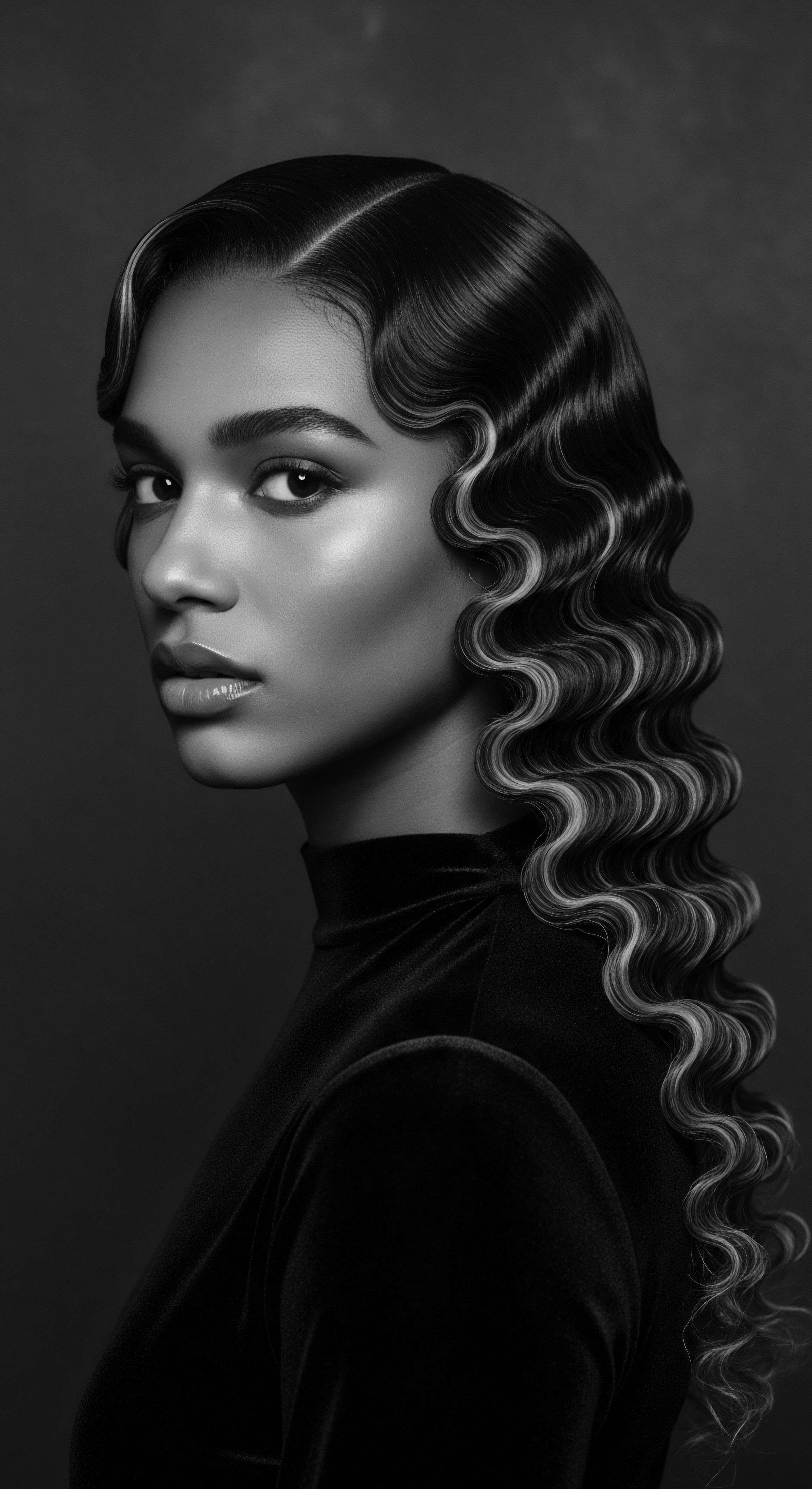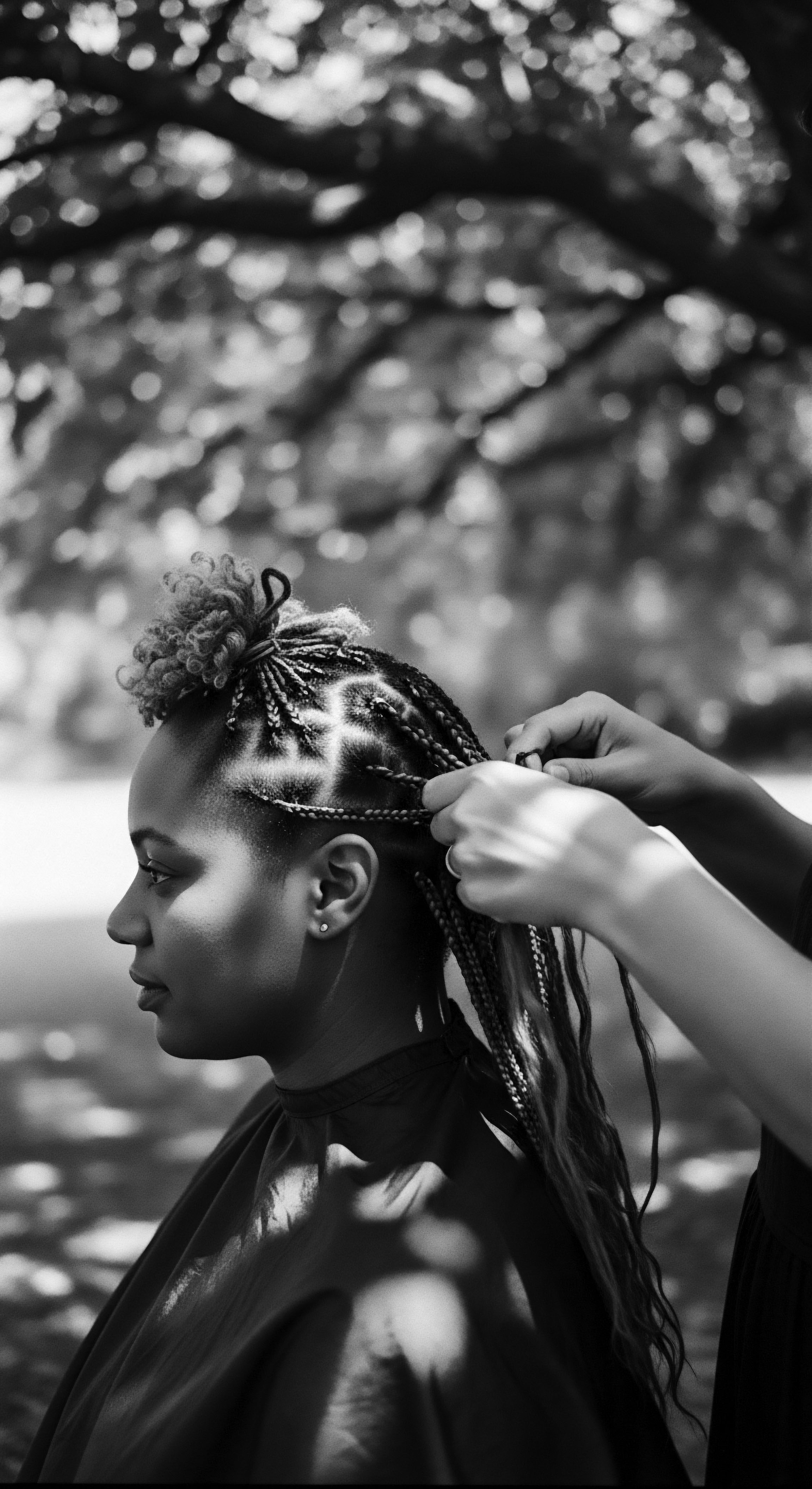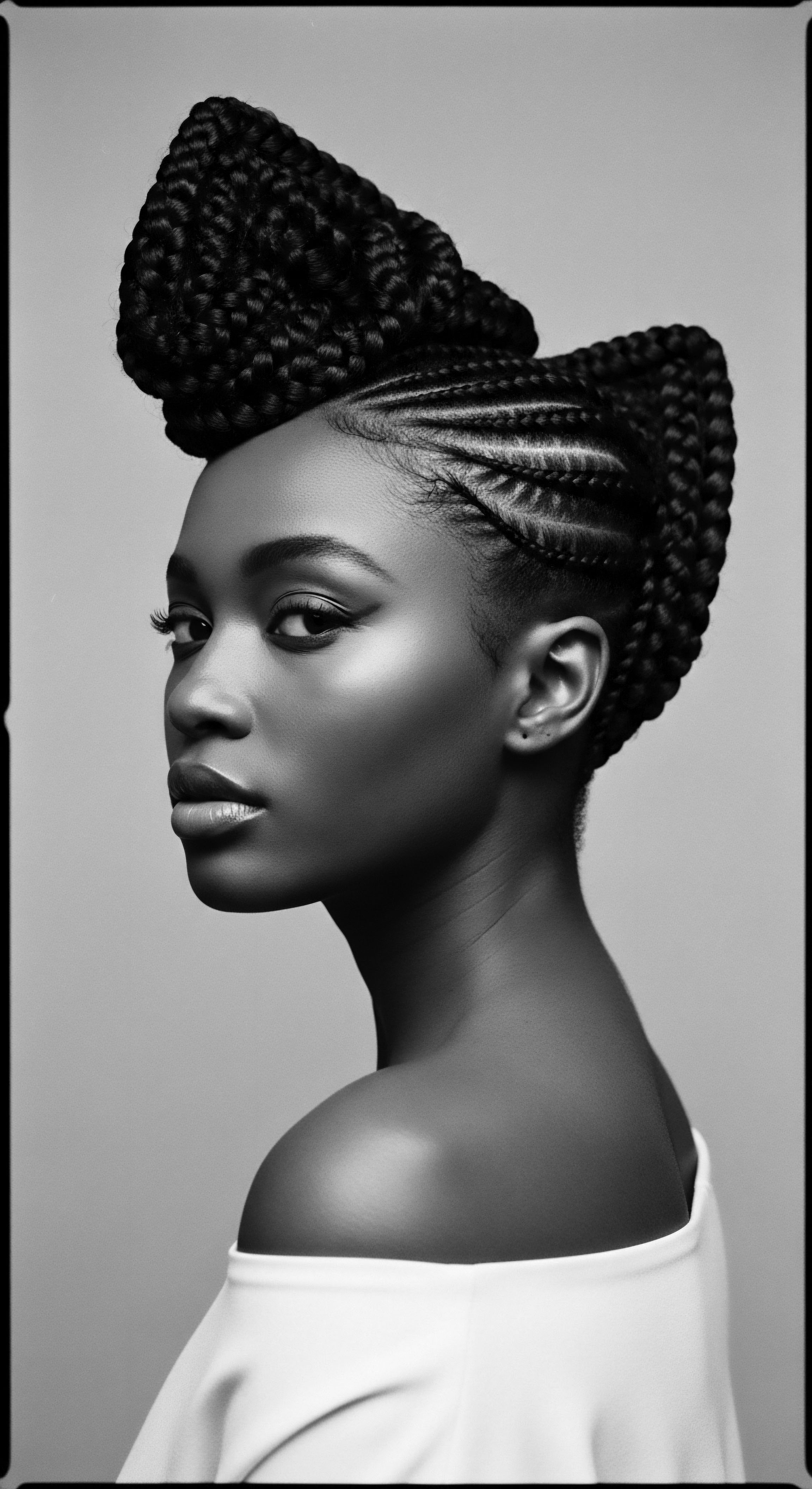
Roots
Across generations, the very strands that spring from our scalps have whispered stories, echoing the resilience and artistry of those who came before us. For communities rooted in Black and mixed-race heritage, hair is far more than mere biological filament; it is a living chronicle, a tangible connection to ancestral wisdom, and a profound declaration of self. To understand the tools we use today for textured hair—the wide-tooth combs, the precise picks, the very concept of gentle manipulation—we must first kneel at the source, acknowledging the elemental biology and the ancient hands that first began shaping and caring for these magnificent coils and kinks.
The journey begins with the hair itself, a marvel of biological design. Textured hair, in its myriad forms, possesses a unique elliptical follicle shape, dictating its distinct curl pattern, ranging from broad waves to tightly wound Z-patterns. This structure, while granting incredible volume and versatility, also presents specific challenges. Its natural bends mean more points where the strand can lift from the scalp, making it prone to dryness and tangles.
Early civilizations understood this intuitively. Their knowledge wasn’t codified in scientific journals, of course, but it was etched into practice, passed through hands and spoken word. The earliest “tools,” if one can call them that, were often simply extensions of the body ❉ fingers, meticulously separating, twisting, and coiling.

What Early Material Culture Reveals About Hair Care?
Archeological discoveries across Africa paint a vivid portrait of early hair care ingenuity. From the ancient Nile Valley to the flourishing kingdoms of West Africa, excavations have unearthed a wealth of grooming implements. These weren’t crude, haphazard creations. Many were meticulously carved from natural materials readily available ❉ wood, bone, ivory, and even specific plant fibers.
The recurring design elements of these earliest combs and picks often show a clear understanding of textured hair’s unique needs. Consider the sturdy, widely spaced teeth evident in combs dating back thousands of years from ancient Egyptian tombs or from various West African sites. These early designs prioritized efficient detangling without excessive pulling or breakage, a testament to an intuitive knowledge of hair mechanics long before microscopes revealed the helical structure of the strand.
Ancient combs, crafted from earth’s bounty, reveal an early, intuitive mastery of textured hair’s distinct character.
These ancestral tools were functional objects, certainly, yet their significance often transcended mere utility. They were frequently adorned with intricate carvings, symbols, and motifs that spoke to status, identity, spiritual beliefs, or tribal affiliation. A comb might signify a woman’s readiness for marriage, a warrior’s prowess, or a community’s reverence for ancestors.
This integration of practical application with profound cultural meaning is a hallmark of ancestral practices. It contrasts sharply with a purely utilitarian view of modern tools, reminding us that for our forebears, hair care was a holistic practice, deeply connected to one’s spiritual and social fabric.
Understanding the core lexicon of textured hair itself also draws from these roots. Terms like ‘coily,’ ‘kinky,’ and ‘curly’ describe the visual patterns, yes, but the ancestral understanding extended to the very behavior of the hair. The ‘shrinkage’ of tightly coiled hair, its apparent reduction in length when dry, was not a defect but a characteristic understood and often celebrated in traditional styling, where techniques aimed to either stretch or define this natural phenomenon. The very act of caring for hair, whether braiding, twisting, or oiling, was a way to engage with its intrinsic nature, rather than to alter it fundamentally.

Ancestral Materials and Their Enduring Wisdom
The choice of materials for early hair tools was never arbitrary. The earth provided all that was needed, and ancestral communities possessed deep knowledge of their local flora and fauna.
- Wood ❉ Often sourced from trees like mahogany or ebony, chosen for durability and smoothness, minimizing snagging on delicate hair strands.
- Bone/Ivory ❉ Utilized for strength and natural glide, allowing for robust detangling and styling. These materials were frequently polished to a high sheen.
- Plant Fibers ❉ Used to create brushes or soft bundles for cleansing and applying natural treatments, providing a gentle touch on the scalp and hair.
- Clay/Minerals ❉ Sometimes incorporated into tools or used as part of cleansing rituals, offering exfoliating or clarifying properties.
The sheer intelligence behind these material choices, combined with the ergonomic designs, speaks to a heritage of innovation. The very concept of a tool designed to reduce friction and breakage, the fundamental principle behind a modern wide-tooth comb or detangling brush, found its genesis in these ancient, handcrafted implements. The knowledge of which materials would best serve the hair’s integrity was part of a larger wisdom that saw the body as interconnected with the natural world, a philosophy that continues to resonate in holistic hair wellness today.

Ritual
The rhythm of hair care, stretching back through millennia, has always held a ceremonial cadence, a tender thread connecting daily practice to a larger cultural narrative. Ancestral hair rituals were rarely solitary or purely aesthetic acts; they were communal, deeply embedded in life passages, and often served as powerful vehicles for knowledge transmission. It is within these ritualistic practices—the careful parting, the rhythmic braiding, the generous application of natural elixirs—that the embryonic forms of modern hair tools and styling techniques can be discerned. The transformation of a hair strand into a styled statement wasn’t merely an art; it was a science, intuitive yet precise, passed down across generations.
Consider the ancestral art of styling, which saw hair as a canvas for identity, status, and spirituality. Elaborate braids, intricate cornrows, and lofty updos were not simply hairstyles; they were visual languages. The tools used for these creations were extensions of the hands, designed to assist in sectioning, smoothing, and securing.
While the modern consumer might reach for sectioning clips or fine-tooth combs, their ancestors would have used specialized sticks, smoothed animal horns, or even their sharpened fingernails to achieve similar, often more complex, separations. These early divisions of hair into distinct sections, a fundamental step in most protective styles, set the blueprint for modern sectioning techniques, enabling precision and manageability in even the most expansive styles.
Ancient hands, guided by wisdom and intention, sculpted hair not just for beauty, but for meaning, using tools born of earth and intuition.
The development of the modern detangling brush, with its flexible bristles and ergonomic handles, owes a debt to the ancestral understanding of gentle detangling. While our forebears may not have had a brush with rows of pins, they understood the importance of working through tangles with minimal tension. This often involved applying natural oils or butters to lubricate the hair, then using wide-tooth combs or even their fingers to slowly separate strands from ends to root.
This practice of “finger detangling,” still championed today in many textured hair care regimens, directly reflects an ancestral recognition of hair fragility and the need for mindful manipulation. The evolution of detangling tools moved from single-pronged picks or wide-set combs to multi-pronged rakes and brushes, each iteration building upon the core ancestral principle of reducing stress on the curl pattern.

How Did Ancestral Styling Inform Modern Heat Tools?
The concept of altering hair texture, even temporarily, is not new. While modern heat styling tools like flat irons and curling wands utilize electricity and sophisticated temperature controls, ancestral communities found their own methods for stretching or shaping hair. In some West African cultures, for example, hair was often braided or twisted tightly and then wrapped around heated rods (often made of metal or clay, heated over a low fire) or even around specific gourds to create waves or curls that would hold for a period.
This rudimentary thermal reconditioning aimed to achieve a certain look or to temporarily stretch the hair for easier styling. The careful application of heat, often indirect and regulated by touch, parallels the modern emphasis on heat protectants and controlled temperatures, reflecting an enduring awareness of heat’s potential to modify and damage hair.
The complete textured hair toolkit of today, whether it holds a boar bristle brush, a precise rat-tail comb, or an array of sectioning clips, finds its conceptual ancestors in these earlier implements.
| Ancestral Tool/Practice Wide-Tooth Comb (Wood, Bone, Ivory) |
| Material & Function Carved for gentle detangling, often symbolic. |
| Modern Parallel & Influence Plastic or resin wide-tooth combs, detangling brushes; emphasis on minimal breakage. |
| Ancestral Tool/Practice Styling Sticks/Fingers (Wood, Sharpened Nails) |
| Material & Function Used for precise sectioning and parting. |
| Modern Parallel & Influence Sectioning clips, rat-tail combs for clean parts. |
| Ancestral Tool/Practice Heated Rods/Gourds (Metal, Clay, Natural Forms) |
| Material & Function For temporary hair stretching or curling. |
| Modern Parallel & Influence Electric curling irons, flat irons, blow dryers; controlled heat application. |
| Ancestral Tool/Practice Hair Picks/Needles (Bone, Metal, Thorns) |
| Material & Function To lift, fluff, and create volume or intricate patterns. |
| Modern Parallel & Influence Metal or plastic hair picks, Afro picks, styling pins. |
| Ancestral Tool/Practice The ingenuity of ancestral tools, crafted from available resources, laid the foundation for modern hair care implements, underscoring a continuous heritage of thoughtful design. |
The legacy extends to the very structure of our routines. The systematic approach to cleansing, conditioning, and styling, often involving different tools at different stages, mirrors the deliberate sequencing of ancestral hair rituals. These were not random acts but carefully choreographed processes, each step serving a distinct purpose in maintaining hair health and achieving desired styles. This heritage of intentionality, of treating hair care as a purposeful engagement rather than a mere chore, pulses through the veins of modern textured hair regimens.

Relay
The journey of textured hair tools from ancient ingenuity to modern innovation is a story of enduring principles passed down through generations, often adapting to new contexts and materials, yet retaining a core functionality born of ancestral wisdom. It is a profound relay race of knowledge, where each generation has taken the baton of understanding what textured hair needs and how best to care for it. This continuity is especially vivid when examining the influence of diaspora and the subsequent global exchange of ideas, where ancestral practices found new expressions, sometimes under duress, sometimes in celebration.
The specific historical example of the hair pick serves as a powerful testament to this relay. While the modern metallic or plastic Afro pick gained prominence during the Black Power movement of the 1960s and 70s as a symbol of cultural pride and affirmation of natural hair, its conceptual lineage stretches back through time. Archaeological findings in ancient Egypt, for instance, reveal combs with long, widely spaced teeth, similar in function to lift and shape dense hair. In various West African cultures, similar implements, often carved from wood or bone, were used not only for detangling but also for creating volume and specific stylistic declarations.
This isn’t a direct replication across millennia but a persistent recognition of a particular need ❉ to manage and celebrate the inherent volume and texture of coily hair without flattening it. The modern hair pick, therefore, represents a resurgence and re-contextualization of an ancient design principle, an ancestral practice of volumetric styling reborn in a new era as both a practical tool and a potent symbol.
The enduring design of the hair pick bridges millennia, a quiet declaration of textured hair’s inherent volume and beauty, echoed from ancient civilizations to modern movements.

How Does Ancestral Philosophy Inform Holistic Hair Wellness Today?
The ancestral approach to hair care was, at its heart, holistic. It understood that hair health was intrinsically tied to overall wellbeing, diet, environment, and even spiritual harmony. This perspective contrasts sharply with a purely product-centric view, which often dominates contemporary beauty narratives. Many traditional communities relied on natural ingredients readily available from their local ecosystems – plant oils, butters, herbs, and roots – not just for external application but often as part of a nourishing internal diet.
This holistic philosophy continues to guide modern wellness advocates who champion plant-based ingredients, mindful routines, and a connection between inner health and outer radiance. The widespread modern appreciation for shea butter, coconut oil, and various herbal infusions in textured hair products can be traced directly to their long-standing, ancestral use across African and diasporic communities for millennia.
The Regimen of Radiance, as we consider it, is deeply informed by these historical continuities. Nighttime rituals, for instance, are not a recent innovation. Ancestral practices often included protecting hair during sleep to prevent tangling and preserve intricate styles. While the modern bonnet or silk scarf might be the tool of choice today, earlier communities used finely woven fabrics or even natural leaf coverings to shield their meticulously styled hair from friction and environmental elements.
The intent was the same ❉ to minimize manipulation and preserve moisture, extending the life of a style and safeguarding the hair’s integrity. The widespread adoption of satin and silk bonnets in the textured hair community today speaks directly to this inherited wisdom, validating ancestral insights with modern fabric technology.
Consider the systematic approach to hair care found in many traditional practices. In some cultures, children learned the proper techniques for detangling, braiding, and oiling hair from a young age, often through observation and direct participation. This pedagogical relay ensured that intricate knowledge of hair texture, its needs, and the tools required to care for it was never lost. This mirrors the modern emphasis on understanding one’s own hair type, developing personalized regimens, and educating oneself about ingredients.
The problem-solving compendium for textured hair, addressing issues like dryness, breakage, or scalp irritation, often finds its most effective solutions in practices that echo ancestral remedies. For example, the use of aloe vera for soothing scalp irritation or fermented rice water for strengthening strands has ancient roots, now often validated by contemporary scientific study into their chemical compounds and beneficial properties.
- Aloe Vera ❉ Used ancestrally for soothing scalp and moisturizing hair, now researched for its anti-inflammatory and hydrating properties.
- Shea Butter ❉ A staple in West African communities for millennia, it provides intense moisture and protection, a core ingredient in modern creams and conditioners.
- Hibiscus/Amla ❉ Traditional Ayurvedic herbs, long used for strengthening and promoting hair growth, now popular in natural hair masks and oil infusions.
The resilience of textured hair traditions, and the tools associated with them, stands as a testament to the enduring power of heritage. Despite historical attempts to suppress or devalue natural Black and mixed-race hair, these ancestral practices persisted, often in quiet defiance, carried forward by those who understood their profound cultural and personal significance. Modern hair tools, in their design and application, are not merely products of industrial innovation; they are profound testaments to an unbroken lineage of care, ingenuity, and a deep, abiding reverence for the soul of a strand.

Reflection
The journey through the ancestral practices that shaped our modern hair tools for textured hair has revealed a tapestry richer and more intricate than mere utility. It is a story of enduring ingenuity, profound cultural meaning, and an unbroken lineage of care. From the very first fingers separating coils, to the carved combs of ancient kingdoms, to the contemporary detangling brushes and bonnets, each tool carries the echoes of hands that understood, honored, and celebrated the unique spirit of textured hair. This exploration is a testament to the idea that our hair, in its magnificent helix, is not just a biological wonder, but a living archive—a repository of collective memory, resilience, and beauty.
The ‘Soul of a Strand’ ethos reminds us that true wellness extends beyond product and technique; it resides in understanding our roots, acknowledging the historical narratives woven into each curl, and drawing strength from the wisdom of our forebears. As we reach for a wide-tooth comb or secure our coils for the night, we are participating in a conversation that spans millennia, a continuous affirmation of identity and heritage. The modern tools are not replacements for ancestral knowledge, but rather, they are its direct descendants, carrying forward the same fundamental principles of gentle care, thoughtful manipulation, and the profound reverence for textured hair that has always existed. Our hair remains a vibrant, unbound helix, connecting us to a deep and resonant past while shaping a future where its beauty and heritage are unapologetically celebrated.

References
- Byrd, Ayana, and Tharps, Lori. Hair Story ❉ Untangling the Roots of Black Hair in America. St. Martin’s Griffin, 2001.
- Okeke, Obi. African Material Culture ❉ A Legacy of Ingenuity. University Press, 2018.
- Maynard, Margaret. The Cultural History of Hair. Berg, 2011.
- Mercer, Kobena. Hair Story ❉ Beauty, Culture, and African American Identity. Duke University Press, 2004.
- Siegel, Marcia B. The World of Hair ❉ An Illustrated Cultural History. Parkstone International, 2012.
- Blay, Z.R. Noliwe. Sisterhood and Safari ❉ From African Hair to African American Identity. Routledge, 2012.
- Akyeampong, Emmanuel Kwaku. The Culture of Hair in African Societies. Journal of African History, Vol. 48, No. 2, 2007.
